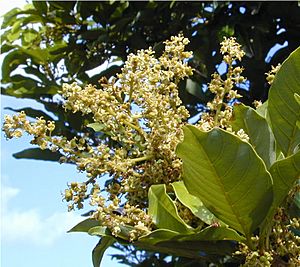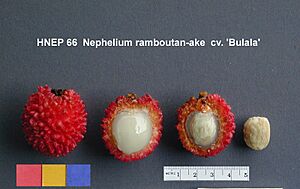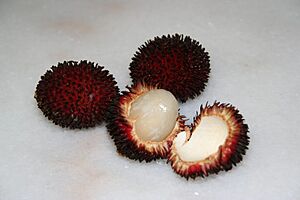Pulasan facts for kids
Quick facts for kids Pulasan |
|
|---|---|
 |
|
| Scientific classification | |
| Genus: |
Nephelium
|
| Species: |
ramboutan-ake
|
| Synonyms | |
|
|

The Nephelium ramboutan-ake, or pulasan, is a sweet tropical fruit. It belongs to the Sapindaceae family, also known as the soapberry family. This means it's a close cousin to other popular fruits like the rambutan, lychee, and longan. Pulasan is usually eaten fresh. It is often sweeter than rambutan and lychee. However, it is quite rare to find outside of Southeast Asia.
Contents
About the Pulasan Fruit
What's in a Name?
The name pulasan comes from the Malay word pulas. This word means "twist." It's similar to the Tagalog word pilas, which means "rip" or "tear." You open the fruit by twisting it with both hands. This is how it got its name!
The Pulasan Tree
The pulasan tree is a beautiful ornamental tree. It can grow to be 10 to 15 meters (about 33 to 49 feet) tall. Its trunk is usually 30 to 40 centimeters (about 12 to 16 inches) thick. Young branches are brown and have tiny hairs. The leaves are long, about 17 to 45 centimeters (7 to 18 inches). They have 2 to 5 pairs of smaller leaflets. These leaflets are dark green and slightly shiny on top. They are paler and a bit bluish underneath.
The pulasan tree loves very humid places. It grows best at altitudes between 110 and 350 meters (about 360 to 1,150 feet). In Malaysia, people say the tree produces the most fruit after a long, dry season.
The Fruit Itself
The pulasan fruit is shaped like an oval. It is about 5 to 7.5 centimeters (2 to 3 inches) long. The fruit is dark red and has a thick, leathery skin. This skin is covered with small, blunt bumps or thick, soft spines up to 1 centimeter long.
Inside, you'll find shiny, white or yellowish-white flesh. This tasty part is called the aril. It is about 1 centimeter thick. The flesh usually separates easily from the thin, grayish-brown seedcoat. The seed inside is light brown and about 2 to 3.5 centimeters long.
The flavor of pulasan is usually much sweeter than that of the rambutan. Unlike the rambutan, the pulasan's flesh comes off the seed very easily. Also, the seed of the pulasan can be eaten raw! It tastes a bit like almonds.
Where Pulasan Grows
Native Home
The pulasan fruit originally comes from Peninsular Malaysia. You can find wild pulasan trees in the lowland forests around Perak, Malaysia. They are also very common in the Philippines, growing at low elevations from Luzon to Mindanao.
Around the World
People have grown the pulasan tree in the Malay Peninsula and Thailand for a long time. It is not as commonly grown in the Philippines. In Java, there were many pulasan trees planted around Bogor and along the railway to Jakarta.
The pulasan tree was brought to Puerto Rico in 1926. Young trees from Java were also sent to Honduras in 1927. These trees were doing well and producing fruit by 1945. Pulasan is not very well known in other parts of the world. However, it is sometimes grown in Costa Rica, and you might find its fruits in local markets there.
Pulasan Life Cycle and Uses
How Pulasan Grows and Reproduces
Pulasan trees can grow from seeds. They can also be grown using grafting methods. Grafting is a special way to join parts of two plants together. This helps prevent diseases and ensures the new tree will produce good fruit. Growing from seeds can be tricky because you might not know if the tree will produce fruit or just flowers.
Pulasan flowers cannot pollinate themselves. This means they need help from insects or other trees. Some pulasan trees have flowers with both male and female parts (hermaphrodite). Other trees have only male flowers (staminate). The hermaphrodite flowers usually act as the female part, and the staminate flowers act as the male part in pollination.
Natural Dye and Other Uses
The skin of the pulasan fruit has a unique color. It can be used to make a natural dye. Scientists have been studying this dye. They are looking at its potential for use in new technologies like organic solar cells. These cells could help create renewable energy.
Pulasan peel has also been studied for its ability to help clean water. For example, it can help remove certain dyes, like methylene blue, from wastewater. This is important because these dyes can harm the environment if released into rivers and lakes.




